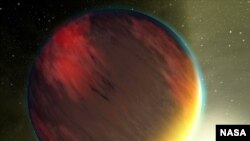Looking for pollution in exoplanet atmospheres may be a promising way to detect intelligent life, according to new research.
Researchers at the Harvard-Smithsonian Center for Astrophysics (CfA) say they might soon be able to "spot the fingerprints of certain pollutants under ideal conditions."
"We consider industrial pollution as a sign of intelligent life, but perhaps civilizations more advanced than us, with their own SETI (search for extraterrestrial intelligence) programs, will consider pollution as a sign of unintelligent life since it's not smart to contaminate your own air," said Harvard student and lead author Henry Lin in a statement.
Specifically, researchers think the James Webb Space Telescope (JWST), slated for launch in 2018, will offer astronomers a chance to detect two kinds of chlorofluorocarbons (CFC) on a faraway world. One caveat is that the levels of CFC in the planet's atmosphere would have to be 10 times higher than here on Earth.
Some CFCs last for 50,000 years, while others break down after just 10 years. Distinguishing between the types on an alien world might say a lot about the planet's history.
"If you don't see the short-lived ones, you may be looking at the ruins of a civilization that killed itself," said Harvard co-author Avi Loeb.
Then again, high levels of pollution could be a sign of an advance civilization, said Loeb.
On a planet just outside the so-called habitable zone, an advanced civilization might purposely flood the atmosphere of a planet with greenhouse gases to warm it up and make it habitable.
According to Loeb, the JWST was not designed with this kind of research in mind, but he thinks that if they find a promising planet, there could be a push to develop technology that would better analyze that planet's atmosphere. One such technology might be able to block the light of the star so that only the light passing through the planet's atmosphere could be seen and studied.
For now, the JWST "can only detect pollutants on an Earth-like planet circling a white dwarf star." White dwarf stars are what remains after a star like the sun dies.
White dwarf stars have only recently become interesting to those in search of extraterrestrial life because it was widely thought that during a star's death, when it swells to what is called a red giant, any planet that might have had life would have been incinerated.
"Turns out in 2011 people discovered two Earth-like planets after the red giant," said Loeb, adding that the planets either survived the red giant phase or formed afterwards.
Pollution Could Be Key to Finding Extraterrestrial Life






